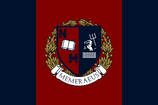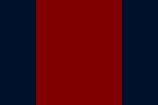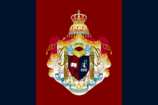Flag of Memeraeus
 |
|
| Use | State flag |
|---|---|
| Proportion | 3:2 |
| Adopted | 28 March 2019 |
| Design | A rectangular triband with vertically ordered fields of blue (left and right) and red, defaced with the state coat of arms in the middle of the red field. The red band is larger than the size of the blue stripes. |
| Designed by | ManuTheSecond |
 |
|
| Use | Civil and state flag and civil ensign |
| Proportion | 3:2 |
| Adopted | 29 March 2019 |
| Design | A rectangular triband with vertically ordered fields of blue (left and right) and red in the middle. The red band is larger than the size of the blue stripes. |
| Designed by | Padzim |
 |
|
| Use | National flag |
| Proportion | 3:2 |
| Adopted | 1 November 2019 |
| Design | A rectangular triband with vertically ordered fields of blue (left and right) and red, defaced with the imperial coat of arms in the middle of the red field. The red band is larger than the size of the blue stripes. |
| Designed by | Padzim |
The flag of Memeraeus contains a medium red vertical band on the centre with two blue stripes framing both vertical sides of the red band.
History
State of Memeraeus (March–October 2019)
Shortly after the establishment of the State of Memeraeus, one of the three founding members decided to reveal the revolutionary and with immediate effect state flag of the micronation. Although the design might look similar to other flags bearing a vertical triband, it is using unique shades of red and blue.
Empire of Memeraeus (November 2019–February 2020)
Since the Imperial House of Memeraeus took over the government of the state, a new flag was introduced; yet, it is strictly used by the members of the Imperial Council and only for imperial affairs. Therefore, the state flag remains the same as before.
Flag specifications
Colours
| RGB code | HSV values | Hexadecimal | |||||
|---|---|---|---|---|---|---|---|
| COLOUR NAME English (Greek) | R | G | B | h | s | v | Hexadecimal code |
| Navy Blue (Ναυτικό Μπλε) | 0 | 17 | 43 | 216.28° | 100% | 16.86% | #00112B
|
| Red (Ερυθρό) | 128 | 0 | 0 | 0° | 100% | 50.2% | #800000
|
Other flags currently in use
Military flags
In order to protect its claimed territory, the State of Memeraeus decided to re-establish the "Armija" troops as full-scale military corps. The main forces are the Army, the Air Force and the Navy.
Army
-
Army flag,
March 2019–Feb 2020
The army regimental war flag used by Memeraeus consists of three almost equally sized horizontal fields (blue, red and blue), featuring a white cross surrounded by a laurel wreath in the centre of the red field. Below the central part, the flag features the motto of the State, "Noli meme tangere" (Latin for "Touch meme not"). The flag's design is derived from the obverse flag used by Alexander Ypsilantis, leader of Filiki Etairia, founder of the Sacred Band who initiated the Wallachian Uprising (Iași, 1821) with the purpose to aide the Hellenic Revolutionary forces during the Hellenic War of Independence.
Air Force
-
Air Force flag,
March 2019–Feb 2020
The air force ensign, inspired by the Hellenic Air Force and civil air ensign (1973–1978), features a version of the former Hellenic land flag, using darker blue shades, defaced with the Memeraeus Roundel in the centre of the white cross. Just below the Roundel, the flag features the Byzantine Double-headed Eagle, coloured using the shade of blue featured on the same flag.
-
Naval jack,
March 2019–Feb 2020
The naval ensign used by Memeraeus consists of three almost equally sized horizontal fields (red, blue and red – the opposite design of the army flag), charged with a white anchor in front of two crossed Minoan dolphins (deducted from a famous fresco) off-centred toward the hoist. The colours were purposely reversed, in order to emphasize the blue colour of the sea. The dolphins are an homage to the Greek naval tradition.
Other forces
Memeraeus also featured flags for the designated forces of Police, Thot Patrol, Border Control and the provisional Space Force.
Police Force
-
Police Force flag,
March 2019–Feb 2020
The flag of the national police force of Memeraeus, the force responsible for patrolling inside the building of the university, features a red field charged with the coat of arms of the State, surrounded by 53 5-pointed gold (yellow) stars. The design was inspired by the current flag used by the African Union. The red colour symbolises the constant battle of the police force to serve the law and establish order among the civilians of the Memeraeus. Early designs of the flag featured a thin horizontal blue line, but eventually it was omitted.
Thot Patrol
-
Thot Patrol flag,
March 2019–Feb 2020
The flag of the thot patrol force of Memeraeus, the force in charge of patrolling for any suspicious thot activity inside the building of the university, features a red field with a blue canton against it. The canton is charged with the alternative coat of arms of the State, surrounded by 14 5-pointed white stars. The design is based on the flag of the Socialist Republic of the Union of Burma (3 January 1974 – 18 September 1988) and the Union of Myanmar (18 September 1988 – 21 October 2010).
Border Control
-
Border Control flag,
Marc 2019–Feb 2020
The flag of the Border Control corps of Memeraeus, a special unit related to the police force features a wide red stripe at the center, bordered by a narrow white stripe both above and below, followed by a blue stripe. The central red stripe carries the coat of arms of Memeraeus within a white circle near the hoist. The design is quite obviously inspired from the flag of Korea DPR (colloquially known as North Korea), yet featuring the colours of the state flag of Memeraeus.
Space Force
-
Space Force flag,
March 2019–Feb 2020
Inspired by the design of the flag of Baykonur, the flag of the provisional Space Force of Memeraeus features three equally sized horizontal fields (blue, red and blue) with a large blue shield with a white outline defaced in the middle of the flag. The shield is bearing a space shuttle in-motion superimposed on a light blue circle. On the left hand side of the circle there are three yellow stars, deducted from the flag of Gagauzia. It generally symbolises the night sky and the dream of discovering a new planet to host mankind. The base of the shield features the Latin proverb "Per aspera ad astra", which translates to "Through hardships to the stars".






